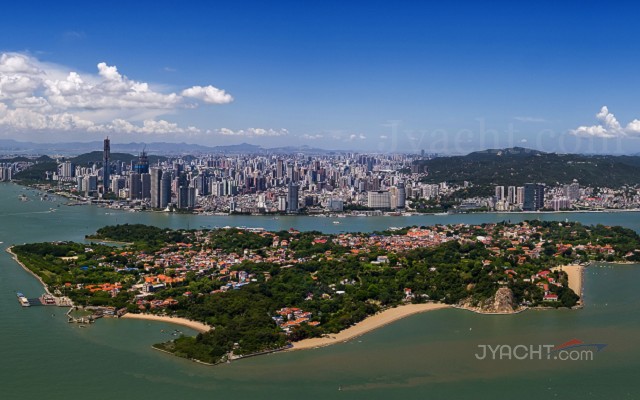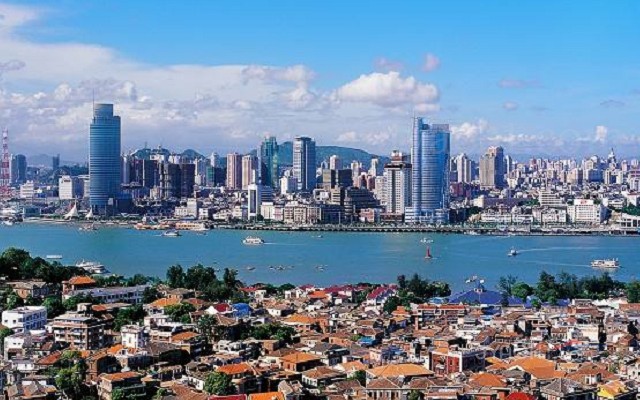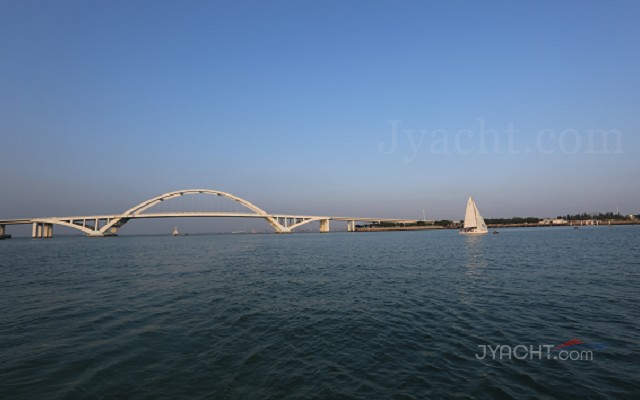Xiamen is just situated in the centre of the west coast of Taiwan straits and the southern Fujian golden triangle area, spanning latitude 23°31’- 28°18’ N and longtitude117°52′-118°26′ E. The city directly faces Jinmen Islands to the east and Longhai city to the south and its land expands to the border of Nan’an city, An’xi county, Changtai county and Longhai city. It consists of the mainland across Xiamen Bay, Xiamen Island, Gulangyu Island and Xiamen Bay. Covering a totaled area of 1,699.39 square kilometers, Xiamen has a land area of 157.76 square kilometers (including Gulang Island) and a sea area of 390 square kilometers.

The city's terrain slope downward from northwest to southeast, most of the landscape in northwest is highly mountainous and hilly. The highest summit in Xiamen is the 1,175.2-meter-high Yunding Mountain at the border of Tong’an and An’xi country. It is characterized by high plains, low plains, terraces, sea alluvial plains and tidal flats from northwest to southeast and its south bank area is Xiamen Island and Gulang Island. Xiamen Island is the fourth largest island in Fujian, on which he highest peak stands 339.6 meters above sea level. While Gulang Island, locating in the southwest bank to Xiamen Island, is separated from Xiamen by a 700-meter-wide Egret River. The Sunlight Rock is the highest peak in the island, 93 meters above the sea level.

Xiamen seas are composed of Xiamen Port, the outer port area, Maluan Bay, Tong’an Bay, the estuary of Jiulon River and its eastern water channel. Islands such as Great Kinmen, lesser Kinmen, Bold Island and Two Gall Island scattering along Xiamen, act as a natural barrier to Xiamen harbor and makes it a natural harbor with deep water all the year around. The coastline resources provide harbor with the capacity to build berths that can accommodate 100,000 tonnage of capacity. For instance, the south of Gulang Island boasting sea area of 14 square kilometers and water depth of 10 meters, is suitable for 100,000-tonnage ships. The inland waterways basically are deep-water channels at a depth of above 10 meters, allowing free access of 50,000-tonnage ships. And the Liuwudian on the east of Xiamen Island can also guarantee the free access of ships capable of ten thousand tons of cargo at once. Xiamen has a coastal line that zigzags to 234 kilometers, among which 43 kilometers belong to deep-water coastline with water depth of 12 meters. The coastline suitable for building berth runs as long as 27 km.

Roughly 1.5 degrees away from the tropic of cancer, Xiamen situates in the subtropical oceanic monsoon climate area. The mean temperature was 20.9 ℃ through the year. It is recorded that the lowest temperature ( Dec. 29, 1991) ever since declined to 1.5 ℃ while the hottest temperature (on Jul. 20, 2007) went up to 39.2℃. Thus we say the city has not winner all the year around. Usually we define spring from mid February till the end of April, summer from early May till the end of October, autumn from the end of October to early February. The rainfall season mainly concentrates on the months from April to August, with the spatial distraction of annual rainfall precipitation forming a decreasing trend from southeast to northwest. The average annual rainfall of Tong’an District and Xiamen Island is 1,464mm and 1,143mm respectively. The wind in Xiamen is dense and fast-moving with an average wind speed of 3.4 m/s and the wind power is measured Grade 8 or above for 22.4 days. Typhoon hits Xiamen in late summer and early autumn more often than any other months. On the average, about one typhoon lands in or among 100 km of Xiamen each year since 1956. The typhoon landed on Aug. 23, 1959 was the strongest in Xiamen with maximum instantaneous wind speed of 60 meters per second. (The instrument was damaged since the limit speed was above the value that the instrument can measure at that time). According to historical records, Xiamen mainly affected by typhoon during the month of August, and the intensity this month could be stronger, the second is the month of July and September. The earliest typhoon so far has been monitored throughout the year is that landing in May 17, 1974 and the latest one is that in Dec. 3, 2004. The strongest typhoon hit Xiamen since the foundation was the Super Typhoon Meranti landing in Xiang’an district costal area.